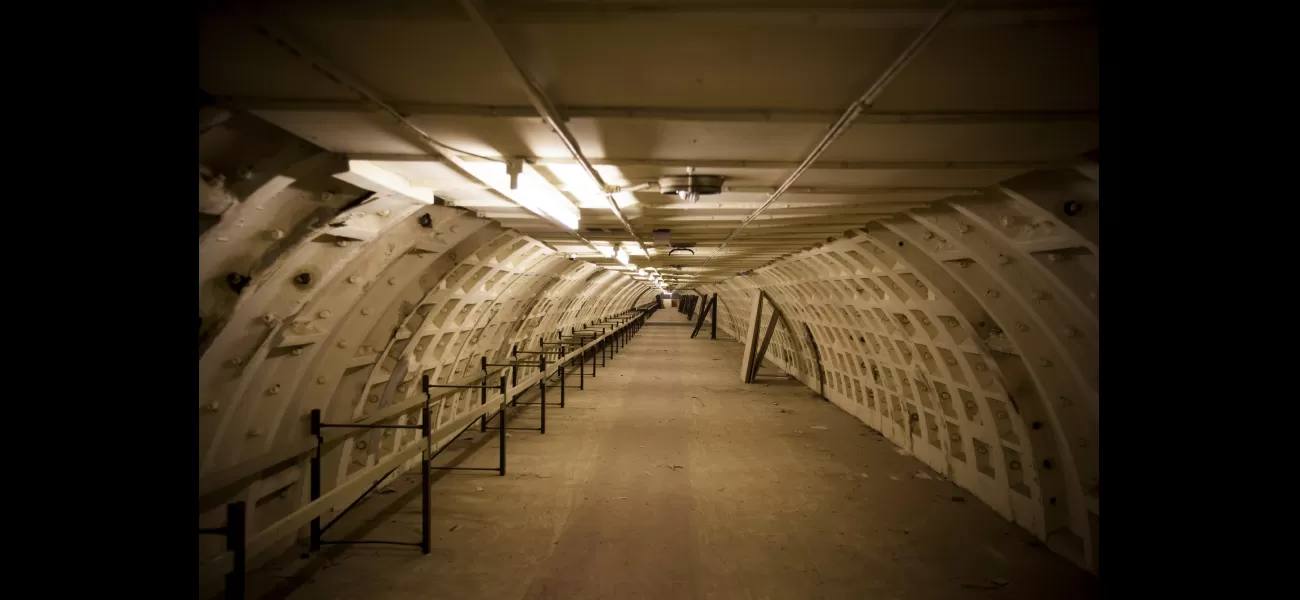London has an underground bomb shelter that could potentially be utilized once more.
Can the shelters be used again?
May 26th 2024.

Human-like Text:
As tensions continue to rise and the threat of war looms, the safety and protection of the British people is at the forefront of everyone's minds. Russian dictator Vladimir Putin has made it clear that he is not afraid to attack the West, and with his recent threats to send a missile to the UK, the people of London are understandably on edge.
London, being one of Europe's largest cities and home to a significant portion of the UK's population, would likely be a prime target for Putin's aggression. However, this is not the first time the UK has faced such a threat. During World War II, the people of London banded together and sought shelter in various locations, including the Clapham South deep level shelter.
In its heyday, the Clapham South shelter could accommodate up to 8,000 people, making it one of the largest deep level shelters in the city. However, with only eight deep level shelters remaining, including ones in Belsize Park, Goodge Street, and Stockwell, there is concern over their functionality and readiness in the event of an attack.
Many of these shelters have been repurposed for other uses, such as archival storage or top-secret telephone exchanges. As such, it would be no small feat to get them up and running again. But with the threat of Putin's attacks looming, it is necessary to consider how these shelters can be adapted for modern times and if they are still effective in protecting citizens.
One of the main concerns is the sanitation and cleanliness of the shelters. In the 1940s, when these shelters were last used, basic amenities such as toilets and showers were available, but certainly not up to modern standards. However, with some upgrades and improvements, these shelters could still provide a safe and sanitary environment for people to seek refuge.
The issue of food and provisions also arises. During World War II, the menu in the shelters was quite limited, with tea and sandwiches being the main offerings. But with the advent of microwaves and electricity in the shelters, there is potential for a more varied and substantial menu. Of course, this would come at a cost, as any profit made from selling food would likely be reinvested into maintaining and running the shelters.
In terms of medical care, basic services were available in the shelters during the war. However, with modern technology and equipment, the level of care could be significantly improved. From basic first aid to more complex procedures, the shelters could potentially provide a safe haven for those in need of medical assistance.
Another consideration is the use of technology in the shelters. While wifi could easily be installed, it may not be the most practical or beneficial addition. The disruption it may cause, with people playing music or watching videos, could interfere with the ability for others to sleep and rest. However, some form of communication may be necessary, whether it be through limited wifi or other means, to allow people in different shelters to stay connected and informed.
In the end, the safety and protection of the people must be the top priority. While there may be challenges and adjustments needed to make these shelters fully functional again, the potential benefits and protection they can provide in the event of an attack cannot be ignored. The people of London have faced threats before and have shown resilience and strength in the face of adversity. With proper preparation and adaptation, these deep level shelters can once again serve as a safe haven for the people of London in times of crisis.
As tensions continue to rise and the threat of war looms, the safety and protection of the British people is at the forefront of everyone's minds. Russian dictator Vladimir Putin has made it clear that he is not afraid to attack the West, and with his recent threats to send a missile to the UK, the people of London are understandably on edge.
London, being one of Europe's largest cities and home to a significant portion of the UK's population, would likely be a prime target for Putin's aggression. However, this is not the first time the UK has faced such a threat. During World War II, the people of London banded together and sought shelter in various locations, including the Clapham South deep level shelter.
In its heyday, the Clapham South shelter could accommodate up to 8,000 people, making it one of the largest deep level shelters in the city. However, with only eight deep level shelters remaining, including ones in Belsize Park, Goodge Street, and Stockwell, there is concern over their functionality and readiness in the event of an attack.
Many of these shelters have been repurposed for other uses, such as archival storage or top-secret telephone exchanges. As such, it would be no small feat to get them up and running again. But with the threat of Putin's attacks looming, it is necessary to consider how these shelters can be adapted for modern times and if they are still effective in protecting citizens.
One of the main concerns is the sanitation and cleanliness of the shelters. In the 1940s, when these shelters were last used, basic amenities such as toilets and showers were available, but certainly not up to modern standards. However, with some upgrades and improvements, these shelters could still provide a safe and sanitary environment for people to seek refuge.
The issue of food and provisions also arises. During World War II, the menu in the shelters was quite limited, with tea and sandwiches being the main offerings. But with the advent of microwaves and electricity in the shelters, there is potential for a more varied and substantial menu. Of course, this would come at a cost, as any profit made from selling food would likely be reinvested into maintaining and running the shelters.
In terms of medical care, basic services were available in the shelters during the war. However, with modern technology and equipment, the level of care could be significantly improved. From basic first aid to more complex procedures, the shelters could potentially provide a safe haven for those in need of medical assistance.
Another consideration is the use of technology in the shelters. While wifi could easily be installed, it may not be the most practical or beneficial addition. The disruption it may cause, with people playing music or watching videos, could interfere with the ability for others to sleep and rest. However, some form of communication may be necessary, whether it be through limited wifi or other means, to allow people in different shelters to stay connected and informed.
In the end, the safety and protection of the people must be the top priority. While there may be challenges and adjustments needed to make these shelters fully functional again, the potential benefits and protection they can provide in the event of an attack cannot be ignored. The people of London have faced threats before and have shown resilience and strength in the face of adversity. With proper preparation and adaptation, these deep level shelters can once again serve as a safe haven for the people of London in times of crisis.
[This article has been trending online recently and has been generated with AI. Your feed is customized.]
[Generative AI is experimental.]
0
0
Submit Comment





